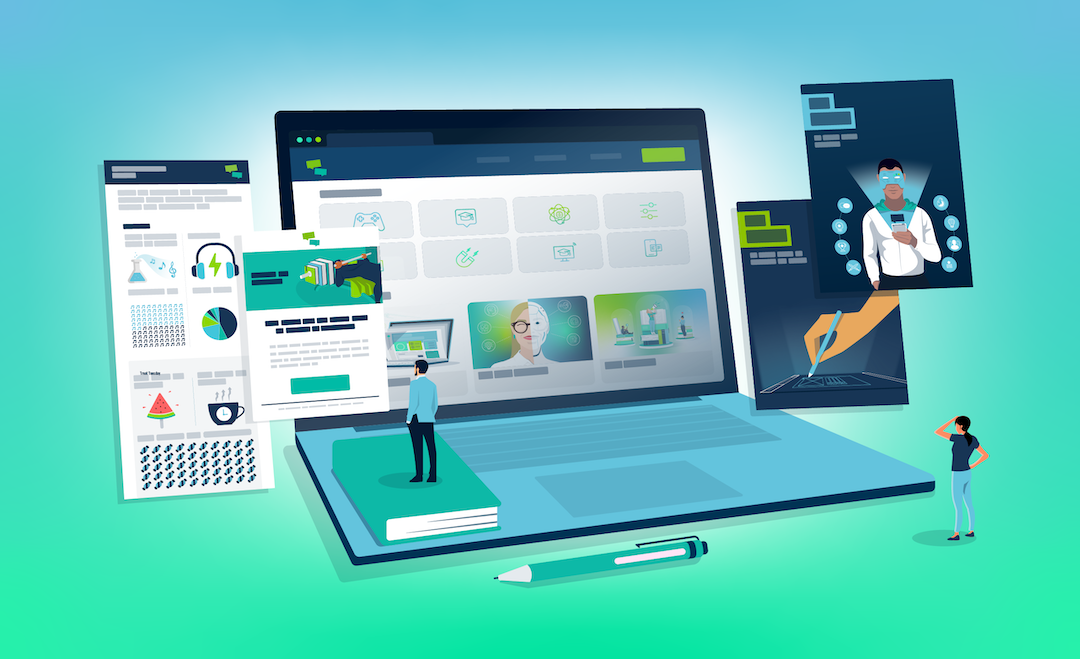 Just-in-time learning is all around us. Think of how often you look up a recipe online or google the spelling of a word. There is almost nothing that search engines cannot find an answer to. Similarly, LinkedIn offers us instant access to subject matter experts in various fields.
Just-in-time learning is all around us. Think of how often you look up a recipe online or google the spelling of a word. There is almost nothing that search engines cannot find an answer to. Similarly, LinkedIn offers us instant access to subject matter experts in various fields.
As a result, your learners are used to having on-demand access to knowledge and skills development. They don’t want to waste time searching for the right information, especially at an urgent point of need.
People now value their time above all else. These expectations, combined with rapidly progressing technology, are the reason behind the rise of just-in-time learning. Now 57% of employees expect learning to be delivered just in time, or as needed.
But how do you create a successful just-in-time training programme? Let’s have a look!
What Is Just-In-Time Learning?
While there is no one set definition, we regard just-in-time training (JIT) as a targeted approach that provides your employees with information at the exact moment they need it.
In other words, JIT training emphasises gaining knowledge only when learners need it, rather than at a later point when the information is less relevant and impactful.
As such, learning is available on-demand, and learners can access relevant content at the point of need. This is a big contrast to more traditional training approaches that only occur at set times or when your learners can catch hold of a subject matter expert.
In a nutshell, just-in-time training provides access to the right information, at the right place and at the right time. For instance, let’s consider a sales representative who needs some customer-critical information to answer queries about a product.
With a just-in-time approach, your sales rep can use their mobile to log in to their learning platform or company database and find the appropriate information.
No wonder why JIT training has become more popular as technology advances and provides more means to access training materials!
But where exactly did this training approach come from?
Origins
Just-in-time approaches have their origins in the world of manufacturing. In fact, the origin is typically attributed to the car manufacturer Toyota, as they created a production system where parts arrive at their warehouse only when they are ready to be distributed.
This synchronised approach helped Toyota reduce the amount of inventory they had lying stagnant. Many other manufacturers have since adopted JIT to reduce their inventory costs and wastage.
Since then, the concept of JIT has made its way to the learning and development (L&D) industry. Organisations and educational institutions alike realised the need to reduce downtime and lower the costs of enrolling employees in long, ineffective, and often boring training courses.
In learning, just-in-time refers to having a stock of ‘parts’, in this case a pool of knowledge, that exists at all times. The information within this pool is available and accessible at all times making learning more streamlined. This is essential as we now expect information to be available at our fingertips immediately.
How Does Just-In-Time Learning Work?

Our attention spans have decreased significantly in the digital age. And this, of course, means that your learners are more likely to be easily distracted. As a result, they will often have a hard time absorbing large amounts of information.
Just-in-time training responds to this issue by offering focused bursts of information or training that can be explored and completed in just a few minutes. When information is delivered in bite-sized chunks, your learners can absorb it quickly whenever they need to.
In addition, L&D experts and practitioners are increasingly trying to integrate training into the flow of work. Just-in-time learning makes this possible by incorporating learning into our everyday lives.
To make this happen, organisations typically use tools like learning management systems (LMSs) or learning experience platforms (LXPs). After all, these platforms collect all training materials together in one place and make it easy to navigate to the right information.
As a learner, just-in-time learning happens when you pay attention to information that you can immediately implement. This means you only focus on the knowledge or skills applicable for a current challenge or skills gap you have identified.
Advantages of JIT Training
Just-in-time can be an extremely beneficial approach to training. After all, modern learners expect information to be readily available whenever they need it, and a JIT approach can help you to meet that need.
As such, it can be a great way to respond to the demands of a knowledge-hungry audience and speed-oriented marketplace.
While the approach does not fit every training need, let’s have a look at some of the benefits in more depth:
1. Improved Employee Performance
JIT training represents one of the most direct links between training and improved performance. After all, knowledge is available at the exact point of need. This means your employees can use their new skills or knowledge right there and then.
Similarly, your employees can stay up to date with the latest information and best practices and perform in their roles more efficiently. As such, JIT approaches focus on helping your employees perform optimally in their roles, by giving them access to the information and tools they need at the right time.
Just-in-time training is especially useful for frontline workers, who have to think and act on their feed in front of customers. It enables them to be more effective and confident in their roles and deliver better results the first time around.
2. Speedy Learning Process
Did you know that corporate learners can typically only devote 24 minutes to learning per week?
Just-in-time training typically focuses on shorter training units. This means that your content is quick to consume, so your learners can focus on putting what they’ve learned into practice. Essentially, JIT training enhances relevance and relatability by providing easy access to content.
In addition, people typically learn faster when they have to learn. Imagine you have been told to learn a certain skill to earn a promotion. This adds a powerful motivation that speeds up the learning process.
3. Budget-Friendly Approach

Just-in-time training is often considered a more budget-friendly approach. After all, organisations don’t have to spend their precious pennies on delivering or creating materials for lengthy face-to-face training sessions or eLearning courses.
Instead, microlearning modules are relatively inexpensive to prepare and use. Similarly, JIT training can save you some time when it comes to developing your training content.
Creating engaging microlearning units is easy with authoring tools, like Growth Engineering Authoring Tool. Simply add your assets, organise your content, select a template and voilà! Your high impact learning content is ready to be shared with your audience.
4. Easy Accessibility
Nowadays, we have an immense amount of information at our fingertips at all times. A couple of clicks or taps are often enough for you to access the information you have been searching for.
And as we have explored, just-in-time training often takes advantage of digital tools. These online platforms and learning apps make it possible to access course material on-demand and on the go easier than ever before.
In addition, just-in-time training material is typically created following microlearning and mobile learning best practices. As such, JIT training is the perfect approach for fast-paced working environments and busy learners.
5. Enhanced Knowledge Retention
Just-in-time training approaches mean that your employees only need to retain the most crucial and long-term information necessary for their roles.
Anything else they can look up as and when they need that information. This reduces cognitive overload, which then leads to better knowledge retention.
Similarly, a lag between learning and application typically results in lower retention of knowledge or skill. JIT training supports immediate reinforcement that helps to transfer new information to your long-term memory.
6. More Engaged Learners

Just-in-time training effectively puts control back into your learners’ hands. They identify what information they need, explore content when it suits their schedule and then apply their new knowledge as necessary.
Knowing that information is just a few clicks away at any time makes for a more confident and self-assured workforce.
They also take a proactive approach to learning, which often leads to more engaged learners.
Build Your Just-In-Time Learning Approach
Just-in-time learning has become increasingly popular the more technology improves. However, organisations often struggle to implement it successfully.
JIT training doesn’t automatically apply to all businesses and learning needs. Nor does it simply mean giving your learners access to content and trusting that they will find the information they need.
As such, you need to focus on building a learning culture, providing the appropriate tools and resources and empowering your learners. With all this in place, you’re sure to benefit from just-in-time learning.
With this in mind, we have created an 8-step process that includes just-in-time training best practices. These eight elements will help you to integrate JIT learning into your organisation successfully.
Let’s take a look!
1. Identify What Is Needed ‘Just In Time’

Not all of your training needs to be available just in time. As such, when you create your JIT training approach, you need to start by determining which training resources should be readily available to your learners.
You can do this by gathering data about common issues your employees face and observing them on the job. This will help you to identify how your employees use your content and what they look for most often.
The analytics available on your learning management system is a great place to start. For example, Growth Engineering LMS’s Reporting Suite allows you to run reports on your learners or content using filters and custom settings. You can then export the data or schedule further reports.
Similarly, it’s always good to talk to your team and ask for suggestions. After all, they have the best idea of what kind of information they need in their roles on a daily basis.
2. Assess Your Current Approach
Before you sink your teeth into creating your just-in-time training programme, you need to assess your current training approach. Only that way can you identify what’s working and what isn’t.
To do so, you should focus on, for example, identifying any learning issues that haven’t been resolved. Similarly, determine what makeshift solutions your learners use to fix common problems or what happens when learning isn’t accessible and your learners don’t know how to progress.
These questions help you to further clarify which training solutions and content should be accessible just-in-time. In addition, it helps you to identify what aspects of your previous training approach you can take advantage of going forward.
3. Develop An Active Learning Culture
Just-in-time training requires a lot of support and effort from your organisation. As such, you need to cultivate a learning culture throughout your organisation to create an effective JIT training approach.
Having learning as a fundamental part of your organisation helps your learners to transition to just-in-time training successfully. After all, training is no longer treated as a separate process but an essential part of the business itself.
A well-cultivated learning culture ensures that your learners get accustomed to searching for information at the point of need. This self-driven learning mindset is essential for JIT training, as it focuses on enabling learners to actively seek out new knowledge and skills for themselves when required.
4. Review Your Digital Tools
Just-in-time training requires responsive technology to work as intended. After all, JIT training highlights flexibility as its number one priority. As such, your digital tools need to be adaptable too.
One of the best ways to ensure effective just-in-time training is to offer a mobile-responsive LMS or a mobile learning solution, like Growth Engineering Learning App. This allows your learners to access training content with ease regardless of their physical location.
And did you know that mobile use has overtaken desktop use? There are also many workforces that don’t have access to a desktop throughout the majority of their working day. If you rely solely on a non-mobile training programme, you are probably not catering for all of your learners.
5. Build Your Content Plan
Next up, it’s time to build your content plan! Rather than creating and pushing out content arbitrarily, creating a content plan lets you deliver the perfect content at the perfect time.
Let’s say there’s a new regulation coming into effect in a couple of months that your learners will need to be aware of. Your content plan will enable you to deliver training just before the regulation comes into effect.
This keeps the content fresh in the minds of your learners and gives them the information they need when they need it.
6. Create Bite-Sized Content

As we have explored, your employees will be accessing content on the go and at the point of need. They expect an answer right away and need to be able to quickly find and process the essentials of the topic.
This can happen at any time, often during the working day. In cases like this, your learners won’t have put much time aside for training. That’s why just-in-time content typically breaks topics down into bite-sized chunks.
With microlearning, you only have room for the most pertinent and high-value information. You’ll need to avoid lengthy and difficult-to-navigate material. Microlearning units can include various formats, like written content, games, videos or infographics.
Essentially, it makes information more digestible and provides the highest relevancy. No wonder why up to 94% of educators prefer microlearning content!
7. Categorise Learning
Your content also needs to be quick and easy to access. JIT training won’t work if your LMS has a complicated, unorganised mass of content. After all, your learners would struggle with finding the information they need in the short time they have available.
Categorising everything makes sure your content is easily searchable. This will help to get it into the hands of your team at the right time. Ultimately, it makes content consumption quick and efficient.
Luckily, today’s modern LMSs’ make this easy by allowing you to categorise your content library and helping you to tag content with keywords! This enables you to group similar concepts together.
8. Use Social Learning Functionality
Just-in-time learning has one major drawback. And that is that JIT training is almost always asynchronous, as learners explore content on their own based on their individual needs.
But just because it’s the norm doesn’t mean that JIT training always needs to remain this way! To give more support and expand your audiences’ learning opportunities, you can take advantage of social learning.
Social learning features on your LMS help learners to access their peers and your organisation’s subject matter experts and mentors. As such, you can create a successful just-in-time approach by merely improving communication.
Tools like Live Chat give learners instant accAll Postsess to a treasure trove of knowledge from their peers. Similarly, asking for help from Experts is a great way to build a source of relevant information. For example, on Growth Engineering LMS, each question and Expert answer is logged in an easily accessible FAQ section.
Take Your JIT Training To The Next Level
While just-in-time training is already technologically driven, it’s moving towards a more participatory environment. Immersive technology, including Augmented Reality (AR), Virtual Reality (VR) and Mixed Reality (MR), will help you to take your JIT approach to the next level!
AR especially is well-suited for creating just-in-time training resources. After all, immersive technology helps to provide timely and contextual information to your employees while reducing the cognitive load associated with more traditional learning materials.
This can be extremely useful for front-line employees. For instance, AR can allow your sales staff to supercharge customer experiences. They can scan products to gain useful product information or have selling tips pop up.
In addition, VR and AR tools allow your employees to take risks, try out their skills and learn from their mistakes in a safe environment. As such, it can further strengthen their confidence and decision-making abilities.
Final Words
JIT can be an extremely beneficial training approach, but only if you have a clear strategy. We hope that these eight steps will help you to implement just-in-time training successfully!
Similarly, you need to know how to create content that is not only bite-sized but engaging and relevant! After all, just-in-time learning is all about accessing the right information at the right time.










